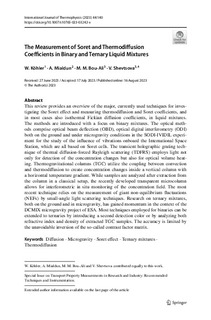| dc.rights.license | Attribution 4.0 International | * |
| dc.contributor.author | Bou-Ali, M. Mounir | |
| dc.contributor.author | Shevtsova, Valentina | |
| dc.contributor.other | Köhler, W. | |
| dc.contributor.other | Mialdun, A. | |
| dc.date.accessioned | 2024-04-11T09:16:42Z | |
| dc.date.available | 2024-04-11T09:16:42Z | |
| dc.date.issued | 2023 | |
| dc.identifier.issn | 1572-9567 | en |
| dc.identifier.other | https://katalogoa.mondragon.edu/janium-bin/janium_login_opac.pl?find&ficha_no=174680 | en |
| dc.identifier.uri | https://hdl.handle.net/20.500.11984/6349 | |
| dc.description.abstract | This review provides an overview of the major, currently used techniques for investigating the Soret effect and measuring thermodiffusion and Soret coefficients, and in most cases also isothermal Fickian diffusion coefficients, in liquid mixtures. The methods are introduced with a focus on binary mixtures. The optical methods comprise optical beam deflection (OBD), optical digital interferometry (ODI) both on the ground and under microgravity conditions in the SODI-IVIDIL experiment for the study of the influence of vibrations onboard the International Space Station, which are all based on Soret cells. The transient holographic grating technique of thermal diffusion-forced Rayleigh scattering (TDFRS) employs light not only for detection of the concentration changes but also for optical volume heating. Thermogravitational columns (TGC) utilize the coupling between convection and thermodiffusion to create concentration changes inside a vertical column with a horizontal temperature gradient. While samples are analyzed after extraction from the column in a classical setup, the recently developed transparent microcolumn allows for interferometric in situ monitoring of the concentration field. The most recent technique relies on the measurement of giant non-equilibrium fluctuations (NEFs) by small-angle light scattering techniques. Research on ternary mixtures, both on the ground and in microgravity, has gained momentum in the context of the DCMIX microgravity project of ESA. Most techniques employed for binaries can be extended to ternaries by introducing a second detection color or by analyzing both refractive index and density of extracted TGC samples. The accuracy is limited by the unavoidable inversion of the so-called contrast factor matrix. | en |
| dc.language.iso | eng | en |
| dc.publisher | Springer Nature | en |
| dc.rights | © 2023 The Authors | en |
| dc.rights.uri | http://creativecommons.org/licenses/by/4.0/ | * |
| dc.title | The Measurement of Soret and Thermodiffusion Coefficients in Binary and Ternary Liquid Mixtures | en |
| dcterms.accessRights | http://purl.org/coar/access_right/c_abf2 | en |
| dcterms.source | International Journal of Thermophysics | en |
| local.contributor.group | Mecánica de fluidos | es |
| local.description.peerreviewed | true | en |
| local.identifier.doi | https://doi.org/10.1007/s10765-023-03242-x | en |
| local.contributor.otherinstitution | https://ror.org/01cc3fy72 | en |
| local.contributor.otherinstitution | https://ror.org/0234wmv40 | en |
| local.contributor.otherinstitution | https://ror.org/01r9htc13 | en |
| local.source.details | Vol. 44. N. art. 140 | |
| oaire.format.mimetype | application/pdf | en |
| oaire.file | $DSPACE\assetstore | en |
| oaire.resourceType | http://purl.org/coar/resource_type/c_6501 | en |
| oaire.version | http://purl.org/coar/version/c_970fb48d4fbd8a85 | en |








